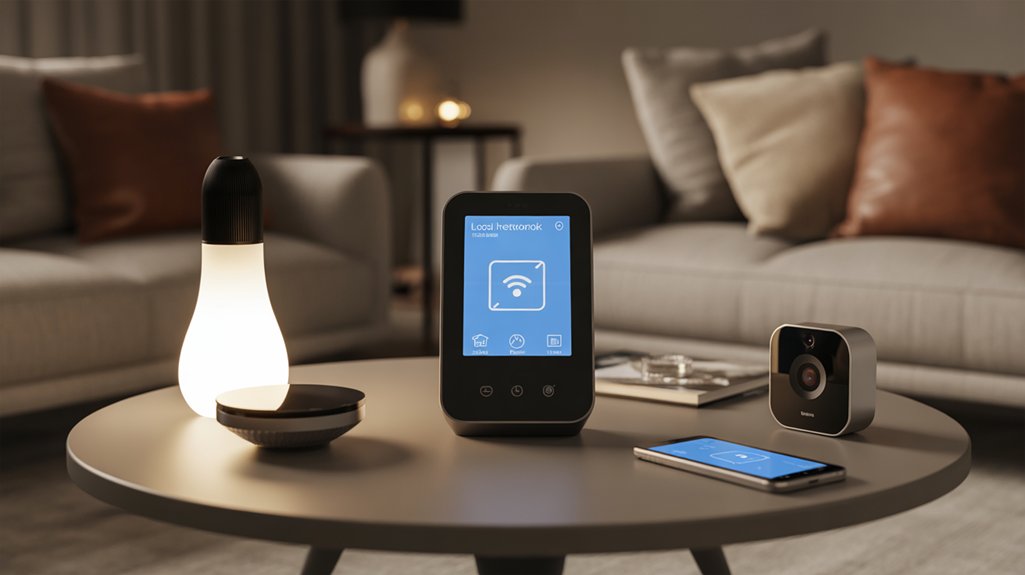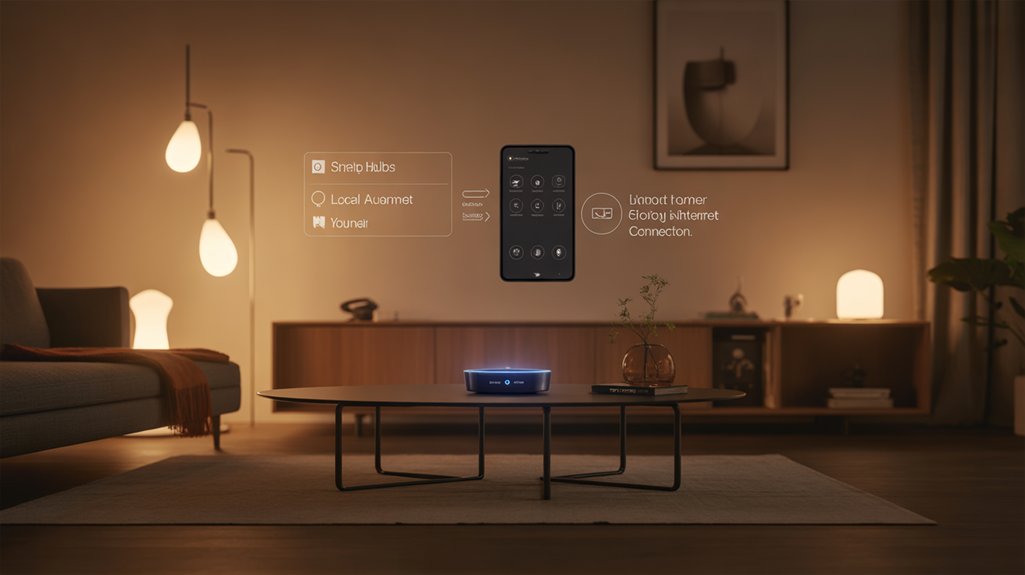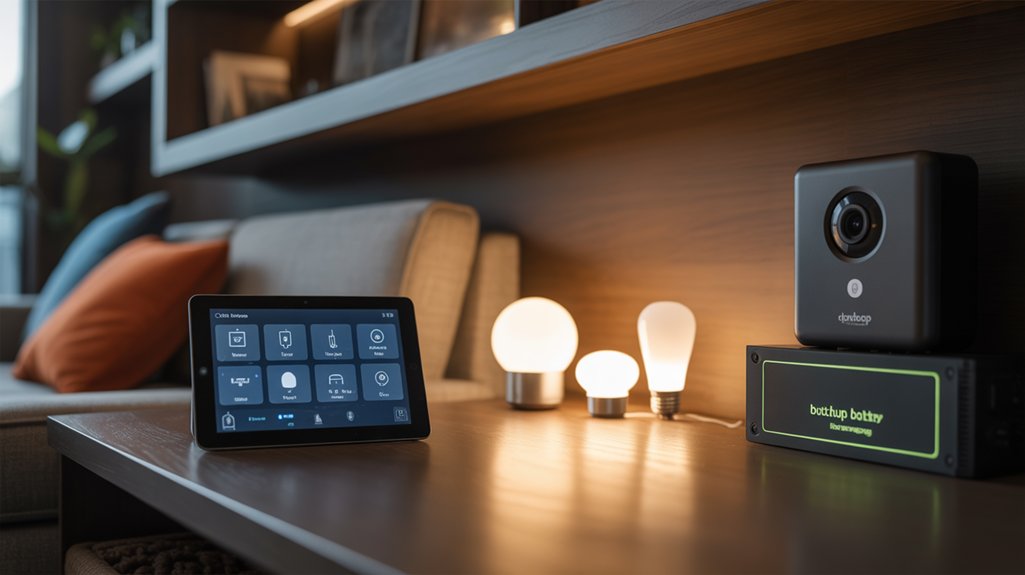You’ll want to build your smart home around local protocols like Zigbee, Z-Wave, or Thread rather than cloud-dependent WiFi devices. Select a hub with strong onboard processing—such as Home Assistant or Hubitat—that executes automation rules locally without internet round-trips. Configure your network with VLAN segmentation and static IP assignments, then test offline functionality by disconnecting your WAN connection to verify motion lighting, thermostat scheduling, and security protocols operate independently. The architecture you implement determines whether your system thrives or fails during connectivity constraints.
Key Takeaways
- Choose hubs with local processing and support for Zigbee, Z-Wave, or Thread protocols to maintain automation without internet dependency.
- Install UPS systems rated for 4-8 hours runtime to ensure continuous hub operation during power and connectivity outages.
- Configure local dashboards, static IPs, and firewall rules blocking outbound requests while permitting internal device communication on your LAN.
- Test offline functionality by disconnecting your gateway from WAN and verifying motion lighting, thermostat schedules, and security protocols operate independently.
- Deploy offline rule engines like Home Assistant or OpenHAB to execute complex automation logic locally without relying on cloud servers.
Understanding Local vs. Cloud-Based Smart Home Protocols

When you configure a smart home device, the protocol it uses determines whether commands traverse your local network or route through remote servers. Local protocols like Zigbee, Z-Wave, and Thread execute operations entirely within your network perimeter, eliminating external dependencies.
You’ll maintain full control during internet outages, achieving sub-100ms response times that cloud architectures can’t match.
Cloud-based systems introduce critical vulnerabilities. You’re subject to vendor server availability, authentication delays, and bandwidth constraints. Each command requires a round-trip to distant datacenters—adding latency and creating single points of failure.
Cloud-dependent smart homes surrender control to external servers, transforming every routine command into a vulnerable round-trip through distant infrastructure beyond your authority.
Understanding this distinction enables you to architect resilient systems. Deploy local protocols for mission-critical automation: lighting, security sensors, and HVAC controls.
Reserve cloud connectivity for non-essential integrations like voice assistants or remote monitoring. This hybrid approach optimizes autonomy while preserving cloud limitations to their appropriate scope.
The emerging Matter standard promises improved interoperability between different smart home ecosystems while maintaining local network capabilities.
You’ll build infrastructure that performs regardless of internet availability.
Choosing the Right Hub for Offline Automation
When selecting a hub for offline automation, you’ll need to prioritize devices with onboard processing power that can execute automation rules without cloud dependencies.
Your hub must support local protocols like Zigbee, Z-Wave, or Thread while maintaining compatibility with your existing device ecosystem.
Consider units with battery backup or UPS integration to guarantee your automations continue running during power disruptions.
Look for hubs like Control4’s Smart Home OS 3, which can connect 13,500 devices on one screen while maintaining robust local processing capabilities.
Local Processing Capabilities Matter
The computational architecture of your smart home hub determines whether automations execute locally or require cloud intermediation. Prioritize hubs with strong onboard processors that handle logic, scheduling, and device communication independently. Local processing eliminates latency and maintains functionality during internet outages, giving you autonomous control over your infrastructure.
Evaluate each hub’s protocol support—Zigbee, Z-Wave, Thread, and Matter compatibility expands your device ecosystem while keeping communications on-premises. Higher-tier hubs feature ARM processors with sufficient RAM to manage complex automation sequences without external servers.
Verify that device compatibility extends beyond basic switching to include conditional logic, scene management, and multi-device coordination. Systems like Home Assistant, Hubitat, and HomeSeer excel at local execution, processing rules entirely within your network perimeter. Your hub’s computational capacity directly correlates with system resilience and response time.
Compatible Protocols and Devices
Protocol selection fundamentally shapes your hub’s ability to operate without internet dependency, as each wireless standard governs how devices authenticate, communicate, and execute commands within your network.
You’ll optimize offline autonomy by prioritizing protocol compatibility across three critical layers:
- Z-Wave delivers mesh networking with 232 addressable nodes, encrypted AES-128 communication, and guaranteed device interoperability through Alliance certification.
- Zigbee 3.0 provides unified specifications eliminating previous fragmentation issues, supporting 65,000 nodes per coordinator with self-healing topology.
- Thread enables IPv6-native architecture with no single point of failure, border router redundancy, and cryptographic device authentication.
Your hub must natively support these protocols without cloud translation layers.
Avoid WiFi-dependent devices requiring manufacturer servers for basic operation.
Direct protocol compatibility guarantees your automation executes commands locally, maintaining full control when internet connectivity fails.
Backup Power Options
Unless your automation hub maintains operation during power interruptions, your offline-capable system becomes vulnerable to the same infrastructure failures it’s designed to circumvent.
You’ll need uninterruptible power supplies (UPS) rated for your hub’s power consumption—typically 5-15W for most controllers. Battery backups should provide 4-8 hours minimum runtime, allowing your automation sequences to execute through brief outages.
For extended autonomy, integrate solar chargers with charge controllers that match your battery chemistry (lithium-ion, LiFePO4, or AGM). Calculate total system draw including network switches, sensors, and actuators.
Industrial-grade solutions offer hot-swappable batteries and generator input compatibility. Monitor battery health through your hub’s API to prevent degradation-induced failures.
Your power architecture directly determines system reliability—compromising here negates your protocol-level redundancy investments.
Best Low-Bandwidth Smart Home Devices and Ecosystems
When building a low-bandwidth smart home, you’ll need to select devices that communicate through protocols designed for local operation rather than cloud dependency.
Zigbee and Z-Wave hubs form the backbone of offline-capable ecosystems, creating mesh networks where devices relay signals to extend range without internet connectivity.
Local processing smart devices—those with onboard controllers and rule engines—execute automation routines directly at the hub level, eliminating latency and bandwidth requirements inherent in cloud-based architectures.
Zigbee and Z-Wave Hubs
Zigbee and Z-Wave hubs function as local mesh network coordinators that eliminate the need for constant cloud connectivity while orchestrating device communication within your smart home.
You’ll gain complete control over your automation infrastructure through these proprietary protocols.
Critical hub comparisons reveal distinct advantages:
- Zigbee advantages: 2.4GHz frequency enables superior device compatibility across manufacturers, though interference issues with Wi-Fi require strategic channel selection.
- Z-Wave benefits: Sub-1GHz operation (908.42MHz US) delivers extended signal range and improved network security through dedicated spectrum.
- Cost considerations: Z-Wave licensing fees increase device prices 15-20% versus Zigbee’s open-source framework.
Both protocols support 232+ nodes per network with AES-128 encryption.
Your hub selection determines interoperability scope—evaluate device ecosystems before committing to either standard for maximum architectural flexibility.
Local Processing Smart Devices
While cloud-dependent devices transmit every command through remote servers, local processing smart devices execute automation logic directly on-premises through embedded controllers and edge computing capabilities. You’ll maintain complete operational control when internet connectivity degrades or fails entirely.
Deploy devices with onboard processors that handle rule evaluation, scene triggering, and sensor-actuator coordination independently. Prioritize hardware supporting Home Assistant, Hubitat, or OpenHAB for maximum local device security and processing autonomy. These platforms execute Python scripts, Node-RED flows, and custom automations without external dependencies.
Conduct rigorous offline functionality testing by disconnecting your gateway from WAN access. Verify that motion-activated lighting, thermostat scheduling, and security protocols continue executing flawlessly. Document which devices revert to default states versus maintaining programmed behaviors during connectivity loss.
This empirical validation guarantees true offline resilience.
Mesh Network Alternatives
Local processing capabilities require strong device-to-device communication protocols that function independently from your broadband connection.
Mesh network benefits include autonomous operation, extended range through node-hopping, and redundant pathways that maintain connectivity during outages. You’ll gain architectural control through three primary protocols:
- Zigbee – 2.4GHz frequency with 65,000-node capacity and AES-128 encryption
- Z-Wave – Sub-1GHz operation eliminating Wi-Fi interference, supporting 232 devices per controller
- Thread – IPv6-native protocol with self-healing topology and superior battery efficiency
However, mesh network limitations demand consideration.
You’ll face interoperability constraints between competing standards, increased latency from multi-hop routing, and coordinator dependency that creates single points of failure.
Protocol selection determines your system’s resilience—choose based on device density requirements, interference profiles, and failover tolerance thresholds.
Setting Up Zigbee and Z-Wave Networks Without Internet Dependency
Before deploying any wireless mesh protocol, you’ll need to understand that both Zigbee and Z-Wave operate on dedicated radio frequencies—2.4 GHz for Zigbee and sub-1 GHz bands (typically 908.42 MHz in North America) for Z-Wave—which function independently of your internet connection.
Protocol comparisons reveal distinct Zigbee advantages: higher data throughput and lower cost per device. Z-Wave benefits include superior range limitations mitigation and minimal signal interference due to its dedicated frequency.
Device compatibility differs considerably—Zigbee supports thousands of nodes per network, while Z-Wave maintains tighter certification standards.
Network security implementation requires encryption at the application layer.
Installation tips: position your hub centrally, adding powered repeater nodes every 30 feet.
Troubleshooting issues typically involve identifying weak mesh points through signal mapping.
Execute automation examples locally: motion-triggered lighting, temperature-based HVAC control, and door lock sequences.
Your controller processes all logic internally, eliminating cloud dependency while maintaining complete system authority.
Creating Automated Routines That Run Locally

Once you’ve established your mesh network infrastructure, you’ll implement automation logic through rule engines that execute entirely within your hub’s processor.
These local triggers eliminate cloud dependencies while maintaining millisecond-level response times.
Configure your automation architecture through three core layers:
- Event-driven triggers – Deploy motion sensors, door contacts, and switches that fire commands directly to your hub without external API calls.
- Conditional logic chains – Program if-then-else statements using device states, time parameters, and sensor thresholds as decision variables.
- Parallel execution paths – Enable simultaneous device commands across multiple protocols to guarantee synchronized responses.
Your automated schedules should utilize the hub’s internal clock rather than network time protocol.
Define routines using cron expressions or interval-based scheduling that persists through internet outages.
Store all automation rules in the hub’s non-volatile memory to survive power cycles.
This architecture grants you complete operational authority over your environment regardless of external connectivity status.
Managing Your Smart Home Through LAN-Only Access
With your automation logic executing independently of external networks, you’ll need direct control mechanisms that bypass cloud interfaces entirely.
Deploy a local dashboard accessible through your LAN’s IP space—Home Assistant’s web interface or openHAB’s sitemap provides protocol-level access to every connected endpoint. Configure static IP assignments for critical devices, ensuring persistent addressability across power cycles.
Local dashboards eliminate cloud dependency—static IP assignments maintain direct device access even when external networks fail.
Implement local network security through VLAN segmentation, isolating IoT devices from primary network traffic.
Enable firewall rules that block outbound requests while permitting internal communication protocols—MQTT, CoAP, and Z-Wave operate effectively within air-gapped environments.
Conduct rigorous device compatibility testing before integration.
Verify each component supports local API access rather than cloud-dependent authentication. Document communication protocols for every device—HTTP REST endpoints, WebSocket connections, or direct TCP sockets.
Establish backup control paths through CLI tools and scripting interfaces.
You’re building a resilient architecture where administrative control persists regardless of internet availability.
Backup Solutions for When Internet Connectivity Drops

When internet connectivity fails, your smart home’s operational continuity depends on pre-configured fallback mechanisms that maintain critical automations.
Device redundancy guarantees failover protocols activate automatically during internet outages, preserving core functionality without cloud dependencies.
Implement these architectural safeguards:
- Z-Wave/Zigbee mesh networks – Local protocols continue executing automations through hub-based processing, independent of WAN connectivity. Configure scene controllers and rule engines to operate entirely within your LAN topology.
- Offline rule engines – Deploy Home Assistant or OpenHAB with locally stored automation logic. These platforms maintain scheduling, conditional triggers, and device orchestration without external API calls.
- Battery-backed gateway infrastructure – Install UPS systems on network switches, hubs, and controllers. This prevents cascade failures when power fluctuations accompany connectivity loss.
Your fallback architecture should prioritize security protocols, lighting automations, and HVAC controls—systems requiring uninterrupted operation.
Test failover sequences quarterly to validate redundancy mechanisms perform as intended under degraded network conditions.
Optimizing Performance on Limited or Intermittent Connections
Limited bandwidth conditions require protocol-level optimizations that reduce payload overhead while maintaining device responsiveness.
You’ll need to implement MQTT with QoS levels appropriately configured—use QoS 0 for sensor telemetry and QoS 1 for critical commands. Configure message retention and last will declaration (LWD) to handle connectivity challenges gracefully.
Deploy edge processing through local gateways that aggregate sensor data before transmission, reducing network calls by 60-80%.
Implement delta-state reporting where devices transmit only changed values rather than complete state objects. You’ll minimize bandwidth consumption while preserving system awareness.
Enable offline capabilities through local caching and command queuing. Your hub should buffer commands during outages and execute them sequentially upon reconnection.
Configure exponential backoff for retry logic to prevent network saturation during intermittent connectivity.
Prioritize traffic using VLAN segmentation, ensuring automation commands receive bandwidth allocation before non-critical IoT telemetry.
This architecture guarantees operational continuity despite network constraints.
Frequently Asked Questions
Can I Control My Smart Home Devices When Traveling Without Internet Access?
You’ll need pre-configured remote access protocols and cellular backup systems to control devices while traveling without internet.
Implement Z-Wave or Zigbee mesh networks with LTE gateways for autonomous operation. Verify device compatibility with offline protocols before departure—some systems require cloud authentication.
Essential traveling tips: establish VPN tunnels to your home network, configure port forwarding rules, and deploy local processing hubs.
You’re commanding infrastructure-level architecture, not consumer-grade cloud dependencies that’ll fail you abroad.
Do Firmware Updates Require Internet or Can They Be Installed Offline?
Most firmware updates require internet connectivity, though you can employ offline firmware installation methods.
Download update packages directly from manufacturers’ support portals onto USB drives or local storage, then manually flash them through your device’s administrative interface.
You’ll need to verify firmware checksums and ascertain version compatibility before deployment.
This approach grants you complete control over update timing and circumvents cloud dependencies, maintaining your system’s operational sovereignty even when internet connectivity isn’t available.
Will My Smart Home Work During a Complete Power Outage?
Your smart home won’t survive a complete blackout without power backup infrastructure.
You’ll need uninterruptible power supplies (UPS) for your hub, router, and critical devices to maintain offline functionality. Battery-powered sensors continue operating, but wall-powered switches, cameras, and actuators fail immediately.
Implement a tiered power architecture: prioritize your automation controller and network equipment with UPS systems, then add battery backups for essential endpoints.
Without electrical continuity, you’re commanding darkness—your authority demands resilient power distribution protocols.
Can Voice Assistants Like Alexa Work Without Any Internet Connection?
No, you can’t utilize full voice assistant capabilities without internet—Alexa and similar platforms require cloud connectivity for natural language processing.
However, you’ll gain limited offline functionality through local device control if you’ve configured specific protocols like Zigbee or Matter beforehand.
Your commands won’t process voice-to-text without servers, but you can architect workarounds using edge computing devices or local voice recognition software.
Ultimately, true autonomous operation demands pre-established local network protocols and compatible hardware infrastructure.
How Do I Troubleshoot Local Network Issues Without Online Support Resources?
Like a surgeon operating without medical textbooks, you’ll rely on systematic troubleshooting techniques to diagnose local network failures.
Start by verifying physical layer connectivity—check cable integrity and switch port status. Execute ping commands to test Layer 3 reachability.
Review DHCP lease tables and ARP caches to identify addressing conflicts. You’ll utilize packet captures via Wireshark to analyze traffic patterns.
Document your network topology beforehand—it’s your blueprint for autonomous problem resolution when you’re operating offline.
Conclusion
You’ve architected a resilient smart home infrastructure that operates independently of cloud services—a fortress of local protocols and offline redundancy. Your Zigbee and Z-Wave mesh networks now execute commands at the edge, while your hub orchestrates routines without phoning home. When bandwidth throttles or connectivity fails entirely, your automation persists. You’ve converted dependency into autonomy, changing your network from a cloud-tethered system into a self-sufficient control plane that answers only to you.




